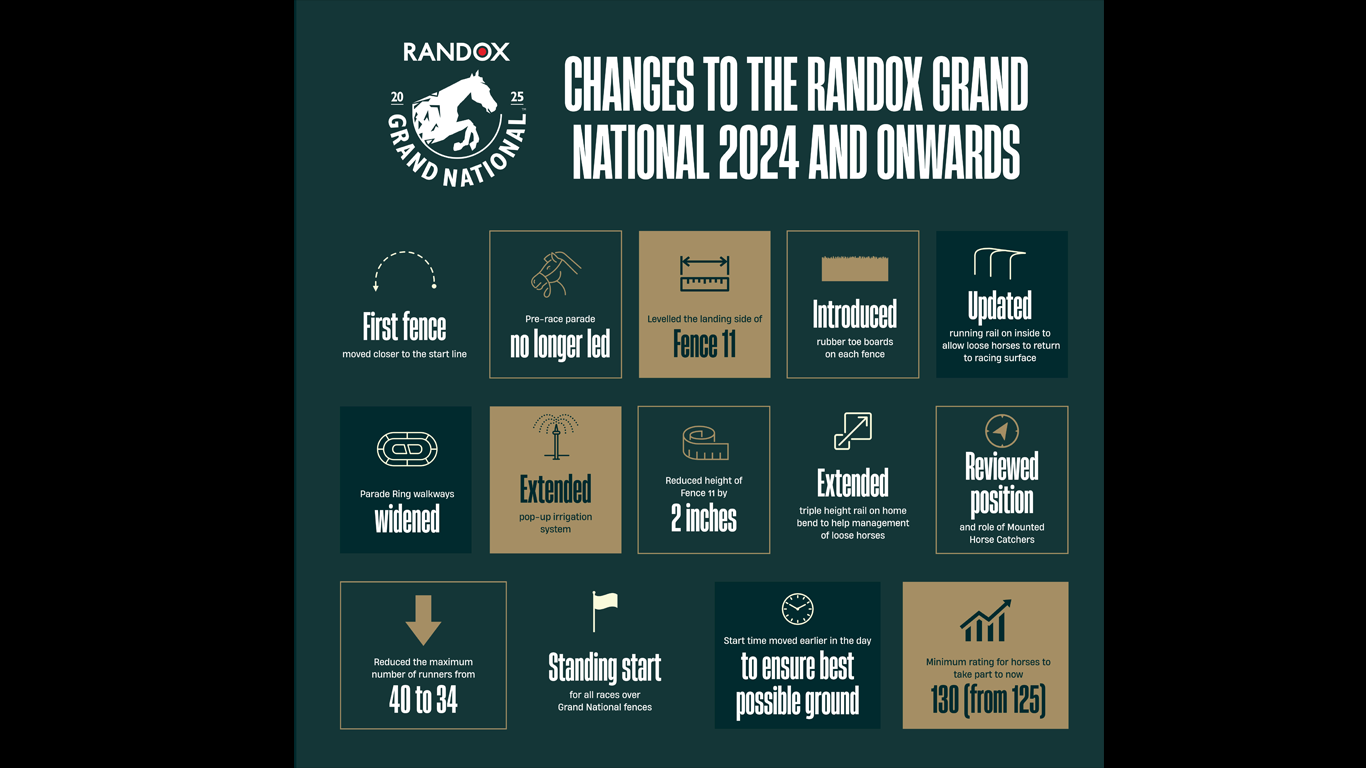HOW NEW MEASURES ENHANCE WELFARE IN THE GRAND NATIONAL
The world's most famous race saw significant changes in 2024 to enhance safety for both horse and jockey.

The Randox Grand National, renowned as the most famous race in the world, has continuously evolved over the last decade to improve the safety of the race for both horses and jockeys. The latest changes were introduced in 2024, with only three falls occurring in the race since that time.
Reducing the field size
For the first time since 1984, the number of runners in the Grand National was reduced from 40 to 34. This change created more space allowing horses to navigate the iconic fences more safely.
Position of first fence and standing start
Data showed that the speed jockeys were approaching the first fence had increased over the years. To reduce the speed and minimise the risk of falls early in the race, the first obstacle was moved 60 yards closer to the start line. The new set up, coupled with a standing start and more prudent riding by jockeys, saw all horses successfully navigate the initial stage of the race, bar one, who unseated his rider but returned home safe and well.
Upgrading the fences
Every year improvements are made to the safety of the fences themselves. In 2024 wooden boards at the foot of each obstacle were covered with foam and rubber, creating a softer landing for any horses that make contact with the fence. The landing at fence 11 was levelled and the fourth-last fence was also lowered by two inches to make the jumps more manageable.
And back in 2013, significant safety improvements were made to every Grand National fence, seeing the solid timber core of the fences removed and replaced with flexible plastic ‘birch’. This makes the fences more forgiving to horses, particularly when errors are made. The race has seen a significant reduction in rotational falls since these modifications were put in place.

Management of loose horses
The running rail has been updated on the inside of the track to better facilitate loose horses and safely remove them from the running. Equally, a triple height rail was installed on the home bend of the course to help the horse catcher team (both mounted and unmounted) to manage those horses that have unseated their rider.
Raising the bar
To compete in the Grand National, the combination of an experienced horse and capable rider is crucial. The minimum rating (a numerical representation of a horse’s perceived ability at any point in time) required for horses to be eligible to race was raised last year from 125 to 130. Equally, jockeys now receive a dedicated safety briefing pre-race, and those who have only raced over the National fences three or less times must walk the entire course with expert jockey coaches in advance, to fully appreciate and prepare for the race’s unique test.
Providing the optimum racing surface
The Jockey Club has invested heavily in Aintree’s track irrigation system, installing pop-up sprinklers to ensure it can create the best possible ground conditions. The provision of an even, predictable surface, reduces the risk of accidents caused by ground instability. But it’s not just about watering. The race’s start time was moved in 2024 to take place 75 minutes earlier, at 4:00 pm, to prevent the ground from drying out too much before the big race begins.

Continuous evolution
The evolution of the Grand National has been ongoing for many years. Changes have included the levelling out steep drops at key fences, installing state-of-the-art cooling systems for horses after the race, and developing a sophisticated watering system to maintain the course's quality.
The measures detailed above are just one part of British racing’s ongoing commitment to reduce risk and improve equine safety and welfare across the sport at all levels. Recent data shows that the overall faller rate in British racing has decreased every year over the past two decades, with the number of fallers in last year’s races down to a record low of just 2.08% of nearly 30,000 runners.
In a race as prestigious as the Grand National, where millions of eyes are on British racing each year, the safety of the horses and jockeys is paramount. With these latest changes, the Grand National is not only offering more thrilling moments for fans but is also leading the way in ensuring the health and safety of its participants. And with an unwavering focus on safety wrapped into its future, the race is on track to remain both iconic and secure for years to come.
To find out more about how horses and jockeys qualify to compete in the Grand National click here.